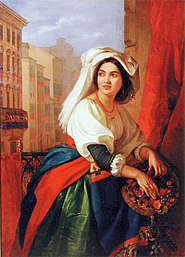Apollon Mokritsky


Apollon Nikolayevich Mokritsky (Template:Lang-uk, Apollon Mokrytskyi; Template:Lang-ru, Apollon Mokritsky, August 1810 – 1870) was a Russian-Ukrainian painter of the Biedermeier period of Realist art. From 1849, he was a full member of the Saint Petersburg Academy of Arts.
Biography
Mokritsky was born in August 1810, in Pyriatyn, Poltava Governorate, modern day Ukraine.[1] His early art education was completed at the Nizhyn Lyceum of Prince Bezborodko, under the supervision of Kapiton Pavlov. After this, he studied at the St. Petersburg Academy of Art between 1830 and 1839, under Alexey Venetsianov and later with Karl Briullov. A year after completing his studies, he worked in Ukraine and visited Italy.
Around 1850, he was appointed "an academician of painting"[2] at the Moscow School of Painting, Sculpture, and Architecture.
He preferred to work in portraiture, representing "the Biedermeier school of uncontrolled Realist art which exhibited romantic overtones".[2] Artist's Wife is one example of this style. Others include portraits of Yevhen Hrebinka (1840) and Nikolai Gogol, a self-portrait (1840), and numerous Italian landscapes.[1]
He is known for the significant role he played in the life of Taras Shevchenko, Ukraine's national poet and artist, who was born a serf. He introduced Shevchenko to the Russian and Ukrainian intelligentsia: artists Karl Briullov and Alexey Venetsianov, poet Vasily Zhukovsky, writer Yevhen Hrebinka, intellectuals Panteleimon Kulish, Vasyl Hryhorovych and others.[2] These individuals became interested in Shevchenko's fate, and helped to secure his freedom from serfdom. Mokritsky left a diary (1975) which contains much material about Shevchenko.[1]
He died in Moscow in 1870, aged 60.
References
External links
![]() Media related to Apollon Mokritsky at Wikimedia Commons
Media related to Apollon Mokritsky at Wikimedia Commons
